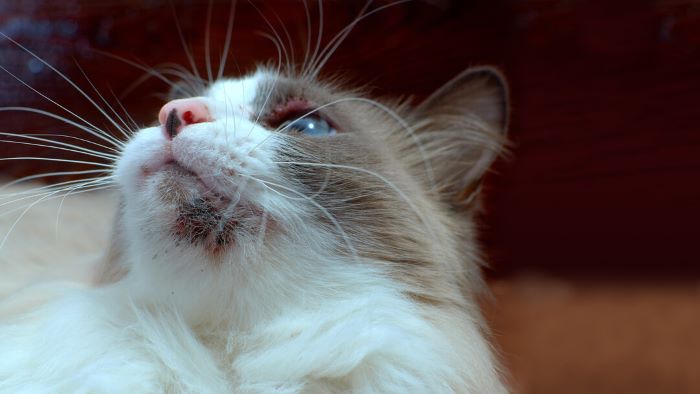Folliculitis refers to an inflammatory skin condition in cats affecting the hair follicles. It causes small red bumps on the skin that may be itchy, painful, or seeping. Multiple factors can trigger feline folliculitis ranging from infections to allergies. Treating the underlying cause and following proper skin care helps clear up folliculitis flare-ups. This article explores the common causes, symptoms, diagnosis, treatment, prevention, and outlook for cats with this condition.
What Causes Folliculitis in Cats?
Folliculitis often stems from a bacterial or fungal infection of the hair follicles. Staphylococcus bacteria frequently trigger staph infections deep within the skin. Ringworm fungus also invades hair follicles leading to irritation and shedding.
Allergic reactions can also spark folliculitis especially to ingredients found in low-quality pet foods or grooming products. Your vet can identify the specific source through skin tests. Less common potential causes include mite infestations or autoimmune disorders.
Signs Your Cat May Have Folliculitis
Typical symptoms involve small red bumps, pustules, crusty scabs or hair loss concentrated on a specific body part or spreading in patches across multiple areas like the:
– Chin
– Face
– Legs
– Tail
– Torso
As bacterial or fungal overgrowth attacks hair follicle tissues, it generates inflammation, itchiness, pain and seepage. Your cat may lick or scratch the affected areas excessively worsening skin damage. Catching and addressing folliculitis early provides the best treatment outlook.
Diagnosing Feline Folliculitis
Start by observing your cat’s skin closely each day checking for abnormalities. Gently part the fur with your fingers to expose the skin across all body areas.
If you discover bumps, hair loss, scabs, or open wounds get your cat examined promptly by its veterinarian. They will first assess for the presence of mites or ringworm. For underlying infections, the vet will take skin scrapings or cultures then analyze samples under a microscope. Blood tests help determine if an overactive immune system could play a role.
By pinpointing the specific cause for inflammation surrounding the hair follicles, the vet customizes the optimal treatment protocol.
Treating Cat Folliculitis
Treating folliculitis aims to eliminate the underlying trigger, control pain and itching, combat infection, and nurse skin back to health. This may involve:
– Antibiotics – Oral or topicals fight bacterial skin infections
– Antifungals – Treat ringworm fungus infesting follicles
– Medicated shampoos – Use a medicated cat shampoo like Veterinary Formula Clinical Care with chlorhexidine and ketoconazole to treat bacterial and fungal skin infections
– Anti-inflammatories – Reduce swelling, irritation, pain, and itchiness
– Immune modulators – Control overactive immune responses
– Omega fatty acids – Daily omega-3 supplements like Welactin for Cats can help soothe itchy, irritated skin
– Antiseptic topicals – Prevent wounds from infection
– Oral vitamins and supplements support skin health
– Steroids help with itching and inflammation
Your vet will prescribe the appropriate selection of treatments customized to the specific cause and severity of your cat’s condition. In most cases, conditions clear within several weeks with proper care.
Preventing Recurrent Folliculitis
Once the active bout resolves, keeping the skin healthy prevents against recurrent flare-ups. Follow these key prevention tips:
– Feed a high-quality diet to nourish skin and coat health
– Avoid irritating ingredients that can trigger allergic skin reactions
– Groom gently using hypoallergenic shampoos like Earthbath Hypo-Allergenic Cat Shampoo formulated for cat skin
– Control parasites like fleas and mites
– Practice good hygiene and properly clean litter boxes
– Follow vet recommendations for ongoing immune-modulating supplements like VetriScience Immune Plus to support your cat’s defenses
– Follow up recheck appointments to monitor skin health
What Is the Long-Term Outlook?
With appropriate treatment guided by a veterinary dermatologist, most cats fully recover from folliculitis within several weeks. Typically no long-term complications arise. However, the condition may come and go when triggered by underlying allergies or immune system problems. Sticking with the prevention methods, customized diet, supplements, and medication regimen aids in keeping recurrent flare-ups at bay.
Catching folliculitis early better ensures prompt recovery without permanent hair follicle or skin damage. Monitor your cat’s skin closely in between vet visits. Seek prompt veterinary care upon noticing any abnormal skin changes to get your cat back to optimal health. Consistent care and prevention helps manage feline folliculitis long-term.
Vet-Recommended Products to Treat & Prevent Cat Folliculitis
Keep your cat’s skin calm, clean, and protected with these expert-approved essentials:
| Product | Category | Use | Shop Now |
|---|---|---|---|
| Veterinary Formula Clinical Care Shampoo | Medicated Shampoo | Fights bacterial and fungal infections (chlorhexidine + ketoconazole) | Check Price on Amazon → |
| Pet MD Antiseptic Wipes | Topical Antiseptic | Cleans hot spots, scabs, and wounds between baths | Check Price on Amazon → |
| Welactin for Cats | Omega-3 Supplement | Supports skin healing and reduces inflammation | Check Price on Amazon → |
| VetriScience Immune Plus | Immune Support | Balances immune system to prevent recurring flare-ups | Check Price on Amazon → |
| Earthbath Hypo-Allergenic Cat Shampoo | Hypoallergenic Grooming | Gently cleans sensitive or allergy-prone skin | Check Price on Amazon → |
| Zesty Paws Aller-Immune Bites for Cats | Allergy Relief Supplement | Eases seasonal allergies and promotes skin resilience | Check Price on Amazon → |
| Capstar Oral Flea Treatment | Flea Control | Fast-acting flea relief to reduce irritation and scratching | Check Price on Amazon → |
| Vet’s Best Flea + Tick Home Spray | Environmental Control | Kills fleas and mites in bedding, furniture, and carpet | Check Price on Amazon → |
Pro Tip: Use a combination of medicated shampoo, internal supplements, and environmental control for best results.



